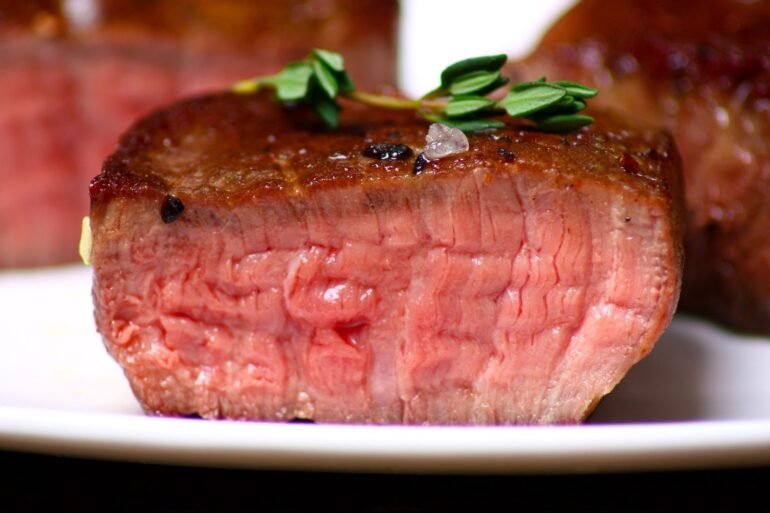:max_bytes(150000):strip_icc():format(jpeg)/Delmonico-Steak-Is-Back-FT-DGTL1025-a2028622d8904cc59c5ac3ab9931ce43.jpg)
Many steak cuts are named relative to their location on the cow — think about a rib eye, sirloin, skirt, or hanger and you can probably picture what part of the animal they come from.
That’s not the case with Delmonico steak, which was named after the historic Delmonico’s restaurant in New York City. In the late 19th and early 20th centuries, the Delmonico had a reputation as one of the highest-quality steaks money can buy, but it’s not clear that it was ever a specific cut, and the term has fallen out of favor. If you’re prepared to talk to your butcher, though, the once-prestigious Delmonico can be a great deal for fans of rib eye and other so-called premium cuts. Here’s what to expect from Delmonico steaks.
What are the origins of Delmonico steak?
Although Merriam-Webster defines “Delmonico steak,” aka “club steak,” as “a small steak cut from the end of the short loin,” when the namesake restaurant opened in 1837, the term was used more as a signal of quality than to indicate a specific cut.
Delmonico was often used to describe “anything considered the best of its kind,” says Dennis Turcinovic, owner and executive culinary partner of Delmonico’s Hospitality Group. “It was known for its tenderness and high quality, usually being a thick steak,” he explains. Today, at Delmonico’s, the cut refers to a boneless rib eye. But historically, the Delmonico steak might have shifted depending on what was available.
Evan Hennessey, chef and owner of Stages at One Washington and The Living Room
“As typically happens within a market, at one time the Delmonico was ‘the’ steak to have.”
— Evan Hennessey, chef and owner of Stages at One Washington and The Living Room
“There are a lot of people who claim to know [what cut it was], but I think the restaurant probably changed the cut often, especially if they were working on a single animal at a time — back then there were no refrigerators or meat–packing plants,” says Steve Sabicer, a former butcher who now runs the Enlightened Omnivore newsletter.
As with many famed dishes, the Delmonico’s meaning evolved — and its popularity ebbed and flowed along with it. “As typically happens within a market, at one time the Delmonico was ‘the’ steak to have,” says Evan Hennessey, chef and owner of Stages at One Washington and The Living Room in Dover, New Hampshire. “But as time went on, other cuts became popular and thus there was a downturn in the Delmonico being ordered.”
Another reason for the Delmonico’s waning popularity might be its ambiguity. “The fact that it wasn’t a specific cut, especially compared to other obvious cuts from the animal,” could make it confusing for diners, Hennessey explains. “But it still remains as the gold standard in luxury steakhouses.”
The rise in popularity of rib eye in the 1950s and ’60s is also believed to have contributed to the decline of the Delmonico. “Don’t get me wrong, people ate rib steaks before that — the French have loved the entrecôte for centuries,” says Sabicer. “I just don’t see it referred to in the U.S. a lot until later in the 19th century.”
Delmonico steak today — and why it’s a good value
Today, a Delmonico steak is essentially a butcher’s choice. While it could be a very thick-cut rib eye steak, it could be something else entirely. For the last couple of years, The Son of a Butcher in Birmingham, Alabama, has sold a Delmonico steak that comes from a loin on top of the chuck roll, which has great marbling and produces a good-quality steak, says head butcher Chris Spear.
The Son of a Butcher’s Delmonico is decidedly more affordable than many other cuts of steak in the glass counter. It runs about $12.99 a pound, while other cuts can cost up to $20 to $30 per pound. A rib eye, for example, may cost you about $35 per pound, while a New York strip might be in the high $20s per pound.
Butchers across the country are dealing with rising costs of cattle, so finding unique ways to save consumers money is important, Spear says. Because the loin is often simply ground with the rest of the chuck, removing the loin and selling it as a Delmonico steak helps keep the price of the ground beef lower.
What to look for
Before that steak hits the heat, it’s a good idea to ask your butcher where on the animal the Delmonico steak was cut from so you know what you are purchasing. Spear says the meat should also be ruby red and have a firm texture that is tender to the touch. Look for a thicker steak with plenty of marbling — those thin white flakes of fat throughout the steak will melt as it cooks and allow the meat to self-baste. “The more fat that’s in the steak, the more flavorful your steak,” Spear says.
Whatever the cut, the Delmonico remains a piece of history that rewards curiosity — and often offers a taste of steakhouse luxury at a friendlier price.
Adam Dolge
2025-10-15 13:00:00

